A LITTLE OF MY STORY
Social media, like a double-edged sword, offers us a world of inspiration and distraction in equal measure. One moment, you’re scrolling aimlessly, and the next, you’re captivated by someone’s vacation snaps that make you yearn for new adventures. A friend’s photos from a pristine, tucked-away destination were so mesmerising that I immediately added it to my bucket list. The stunning landscapes were irresistible, yet the challenge wasn’t getting there—it was timing the trip right. With its brief summer season making it a paradise for nature lovers, and the frigid winter perfect only for those brave enough for winter sports, planning a visit for our family of four during the sweet spot of warmer weather felt like coordinating the stars. But some places are worth the wait.
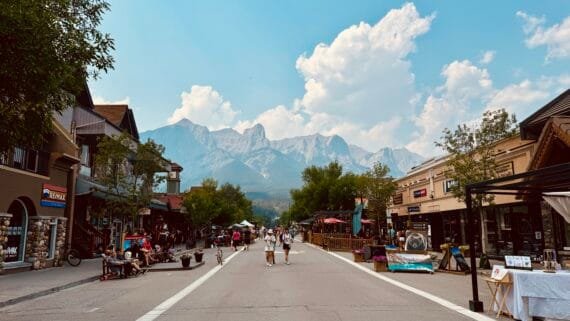 With our kids living out of state, family vacations have become a cherished tradition—moments we treasure as we steal precious time from our busy schedules. Every getaway feels like a small victory, a chance to reconnect through shared experiences and create new memories.This year, one of my long-held dream destinations finally topped our list: Banff, Alberta, Canada. From August 2-7,2024, we embarked on a short but unforgettable journey to this stunning valley town. Our adventure began with a flight into Calgary, followed by a two-hour drive to this picturesque valley town.
With our kids living out of state, family vacations have become a cherished tradition—moments we treasure as we steal precious time from our busy schedules. Every getaway feels like a small victory, a chance to reconnect through shared experiences and create new memories.This year, one of my long-held dream destinations finally topped our list: Banff, Alberta, Canada. From August 2-7,2024, we embarked on a short but unforgettable journey to this stunning valley town. Our adventure began with a flight into Calgary, followed by a two-hour drive to this picturesque valley town.
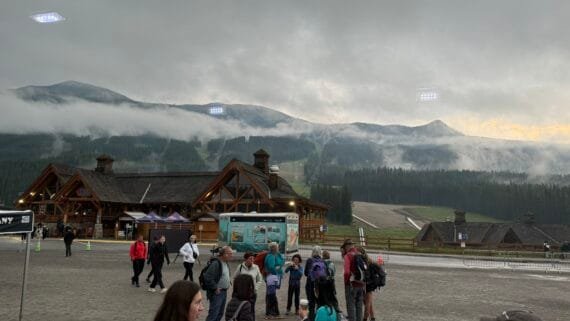
Banff is a charming mountain town nestled in the Canadian Rockies. During the winter, the snow-covered peaks in the subarctic climate draw snowboarding and skiing enthusiasts. However, during the summer, the weather fluctuates between moderate to hot temperatures and is often accompanied by passing rains. During our visit low-hanging clouds drifted below the peaks, creating picturesque views. We even encountered a heavy downpour, giving us a taste of what it means to walk on cloud nine and dance in the rain.
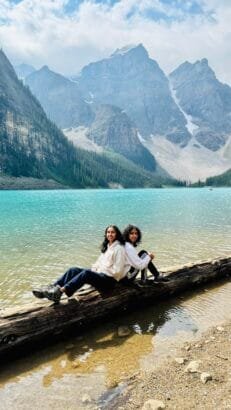
Banff National Park, a UNESCO World Heritage Site, is renowned for its vibrant emerald green or turquoise blue lakes, which change color depending on the sunlight. Often compared to the Swiss Alps, Banff boasts a larger mountain terrain that stretches from Canada to New Mexico. Both locations are top-rated for their natural attractions however, I’ve heard the latter has less extreme weather. Global warming was evident this year as we barely saw patches of snow at the peaks. Additionally, Jasper, a nearby attraction about an hour and a half away, experienced a forest fire and was closed to the public. The road to Jasper is reputed to be beautiful and dreamy, but it was unfortunate to hear that fifty percent of it was under fire during our visit.

The town and surroundings of Banff are uniquely situated, offering something for everyone. Whether camping, hiking, biking, kayaking, strolling in the woods, or walking by the rivers, Banff caters to all kinds of outdoor adventures, ranging from easy to difficult. Even if outdoor activities aren’t your thing you can still enjoy the vibrant atmosphere with a variety of cuisines and pubs to hang out in. The small downtown also offers many art stores and shops for sports gear, staying open until late evening to match the setting sun. This bustling town, full of vibrancy, offers a little bit of everything for all age groups.
We spent the first few days in a lodge that had a charming log cabin vibe from the outside. While there, I came across a coffee table book about the history of American log cabins. It was fascinating to learn how what most Americans now view a log cabin as a fun heroic weekend getaway has a very different origin. Log cabins were first introduced by Swedish colonies in 1638. Later German, Scottish, and Irish immigrant refugees, desperate for shelter, adopted these makeshift homes in the New World as an invaluable symbol of freedom.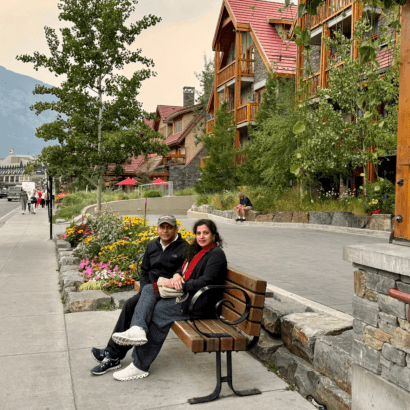 Despite the harsh living conditions, these affordable homes helped millions turn their dreams of settling in America into a reality. For a long time, the wealthy lived in well-built houses, while the poor endured miserable cabins. But in the early 1800s, different writers and artists began to romanticize the log cabin, giving it a positive twist. The lodge we stayed at, though a modern facility, had an old facade designed to evoke the charm of a traditional log cabin.
Despite the harsh living conditions, these affordable homes helped millions turn their dreams of settling in America into a reality. For a long time, the wealthy lived in well-built houses, while the poor endured miserable cabins. But in the early 1800s, different writers and artists began to romanticize the log cabin, giving it a positive twist. The lodge we stayed at, though a modern facility, had an old facade designed to evoke the charm of a traditional log cabin.
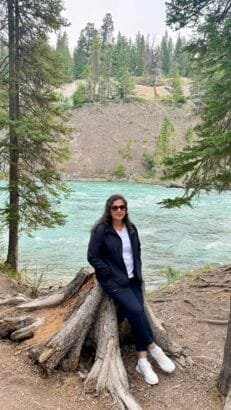
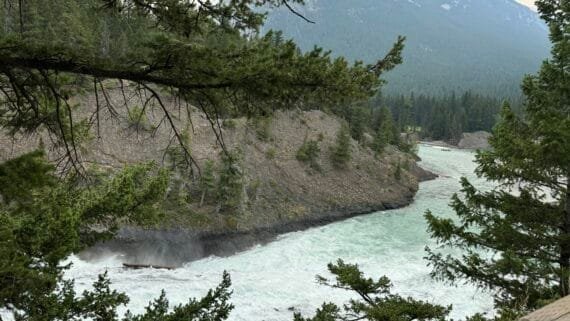 We arrived late on the first night, around 2 a.m., with our only option being to sleep and readjust to the local time. The next morning, after a hearty breakfast, we set out on a trail along the Bow River. The path led us through a serene forest, where the gentle rustling of leaves and the soothing sound of the river created a tranquil atmosphere. The relatively easy trail offered breathtaking scenery. When we reached the peak, we were met with the awe-inspiring sight of the calm river transforming into a powerful waterfall—a moment that truly captured the natural beauty of the area. Along the way, we were delighted to discover local artwork hanging from the trees, adding a unique and artistic touch to the journey.
We arrived late on the first night, around 2 a.m., with our only option being to sleep and readjust to the local time. The next morning, after a hearty breakfast, we set out on a trail along the Bow River. The path led us through a serene forest, where the gentle rustling of leaves and the soothing sound of the river created a tranquil atmosphere. The relatively easy trail offered breathtaking scenery. When we reached the peak, we were met with the awe-inspiring sight of the calm river transforming into a powerful waterfall—a moment that truly captured the natural beauty of the area. Along the way, we were delighted to discover local artwork hanging from the trees, adding a unique and artistic touch to the journey.

Still feeling the effects of our late arrival we opted for an afternoon siesta to recharge. Later that day, we headed downtown and leisurely strolled around to soak in the summer night, with a hint of a chilly breeze adding to the ambiance. We eventually settled at a casual patio for dinner, chatting with kids about their lives and enjoying the relaxed atmosphere before retiring for the day.
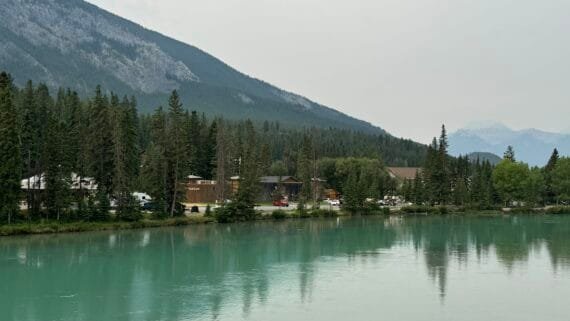
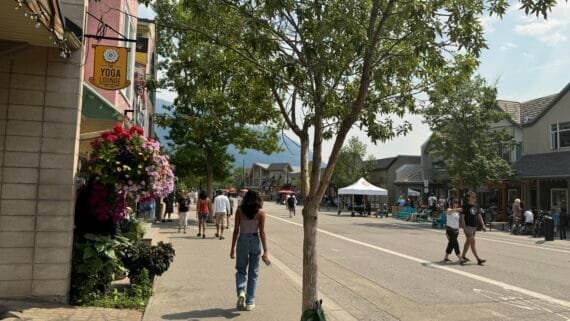 The following day we drove to Canmore, a nearby town west of Calgary, renowned for its rugged peaks like the Three Sisters and Ha Ling Peak. The Grassi Lakes Trail, a highlight of the area, winds past a waterfall to reveal two stunning turquoise lakes. The awe-inspiring mountain terrain surrounding us constantly captivated our senses.
The following day we drove to Canmore, a nearby town west of Calgary, renowned for its rugged peaks like the Three Sisters and Ha Ling Peak. The Grassi Lakes Trail, a highlight of the area, winds past a waterfall to reveal two stunning turquoise lakes. The awe-inspiring mountain terrain surrounding us constantly captivated our senses.
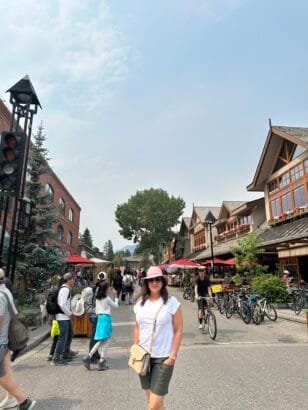 In those two days, we experienced weather fluctuations ranging from the 90°F to the 50°F. In the evening before dinner, we returned to Banff downtown to purchase some weather-appropriate clothing. Most stores catered to mountain and sports gear, with only a few offering summer dresses, which makes sense given the predominantly cold seasons. A friend’s recommendation led us to the best food of the entire trip: fine Indian dining at Zyka. The delicious food was well worth the two-hour wait—though, as they say, hunger only enhances the flavor (it was so good that we returned for breakfast another day). After a hearty meal we retired to our hotel for much-needed sleep.
In those two days, we experienced weather fluctuations ranging from the 90°F to the 50°F. In the evening before dinner, we returned to Banff downtown to purchase some weather-appropriate clothing. Most stores catered to mountain and sports gear, with only a few offering summer dresses, which makes sense given the predominantly cold seasons. A friend’s recommendation led us to the best food of the entire trip: fine Indian dining at Zyka. The delicious food was well worth the two-hour wait—though, as they say, hunger only enhances the flavor (it was so good that we returned for breakfast another day). After a hearty meal we retired to our hotel for much-needed sleep.
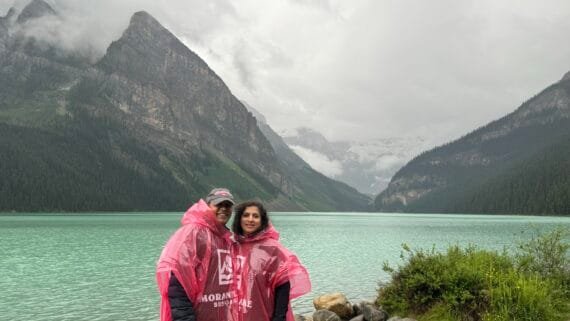 The next morning we checked out very early and drove for almost an hour to catch the tourist bus to Lake Louise and Lake Moraine, two iconic and must-see destinations. When we arrived at Lake Louise it was pouring heavily, which dampened our spirits a bit. However, the tour guide generously provided everyone with rain ponchos and soon we were off to explore the lake. While bright sunlight would have certainly enhanced the beauty, the rain had its own charm. It was hard to take our eyes off the majestic natural scenery. We then took a short trail by the lake, playing hopscotch in the rain puddles, and turned the experience into a memorable adventure.
The next morning we checked out very early and drove for almost an hour to catch the tourist bus to Lake Louise and Lake Moraine, two iconic and must-see destinations. When we arrived at Lake Louise it was pouring heavily, which dampened our spirits a bit. However, the tour guide generously provided everyone with rain ponchos and soon we were off to explore the lake. While bright sunlight would have certainly enhanced the beauty, the rain had its own charm. It was hard to take our eyes off the majestic natural scenery. We then took a short trail by the lake, playing hopscotch in the rain puddles, and turned the experience into a memorable adventure.
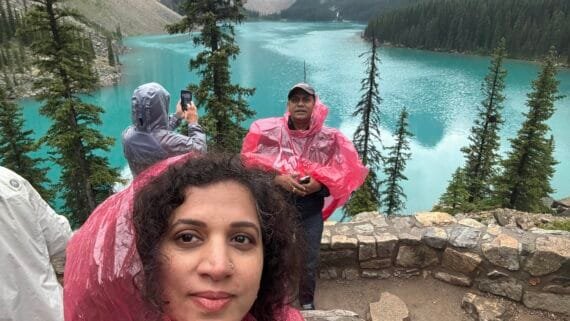 Luckily, by the time we reached Lake Moraine, the sun had broken through the clouds. This made the short hike to the Rockpile viewpoint much easier, where everyone instinctively turned into a professional photographer to capture the breathtaking scenery without the need for any filters. The stunning turquoise lake, cradled by the Canadian Rockies, is truly a sight to behold, as if straight out of a dream. The tall straight pine trees scattered among the rocks created a striking contrast against the vibrant water. It’s a view that one can never get enough of—so captivating and spectacular that even the most talented artist might feel frozen, unable to fully capture its beauty on canvas or in words. My words fail to fully capture the experience here. As we descended from the Rockpile we took a moment to stop by the café and gift store, where we treated ourselves to hot chocolate and samosas—an unexpected delight at this location. To our surprise they were not only a comforting treat, but also incredibly tasty, adding a perfect memory to our visit.
Luckily, by the time we reached Lake Moraine, the sun had broken through the clouds. This made the short hike to the Rockpile viewpoint much easier, where everyone instinctively turned into a professional photographer to capture the breathtaking scenery without the need for any filters. The stunning turquoise lake, cradled by the Canadian Rockies, is truly a sight to behold, as if straight out of a dream. The tall straight pine trees scattered among the rocks created a striking contrast against the vibrant water. It’s a view that one can never get enough of—so captivating and spectacular that even the most talented artist might feel frozen, unable to fully capture its beauty on canvas or in words. My words fail to fully capture the experience here. As we descended from the Rockpile we took a moment to stop by the café and gift store, where we treated ourselves to hot chocolate and samosas—an unexpected delight at this location. To our surprise they were not only a comforting treat, but also incredibly tasty, adding a perfect memory to our visit.
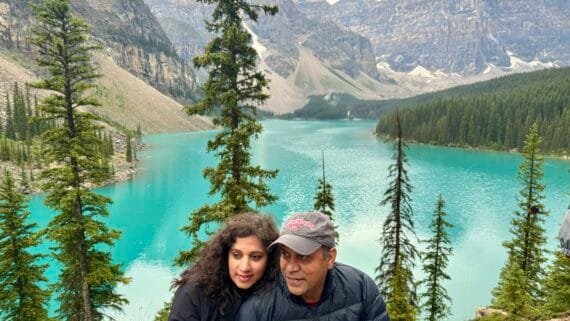
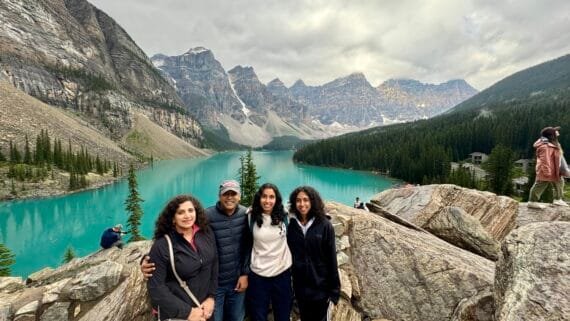
We had a little time before the bus departed so we took a leisurely stroll by the lake, immersing ourselves in nature and capturing its beauty through photos. On our return, the tour guide explained how the lake gets its stunning color. When glaciers melt, they grind against the underlying rock, creating fine particles of sediment known as ‘rock flour.’ These particles are so light that they don’t sink but instead float in the water. When sunlight hits the lake, the rock flour reflects that magnificent turquoise color.
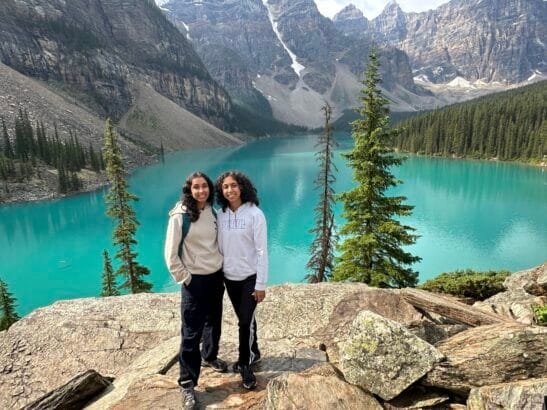 Lake Moraine differs from Lake Louise in that it completely empties out by fall. As the glaciers freeze in the fall, the lake gradually drains, only to be refilled in the following summer. It takes about a month or two for the glacier water to fill the lake basin again. Because the water is refreshed each year, the lake’s color can vary slightly, showcasing different shades of turquoise.
Lake Moraine differs from Lake Louise in that it completely empties out by fall. As the glaciers freeze in the fall, the lake gradually drains, only to be refilled in the following summer. It takes about a month or two for the glacier water to fill the lake basin again. Because the water is refreshed each year, the lake’s color can vary slightly, showcasing different shades of turquoise.
For anyone planning to visit Lake Louise and Lake Moraine, it’s crucial to plan ahead. Private cars are not allowed, and parking spots are limited, often filling up early in the morning. Given the narrow mountain roads, the decision to limit access to tour buses is a smart strategy for better traffic control. During the winter months, the roads are closed to the public due to the risk of avalanches. Additionally, it’s worth noting that Banff’s economy relies heavily on tourism during the few months when the weather is favorable, making it a relatively expensive vacation. Proper planning can ensure that you make the most of this beautiful destination.

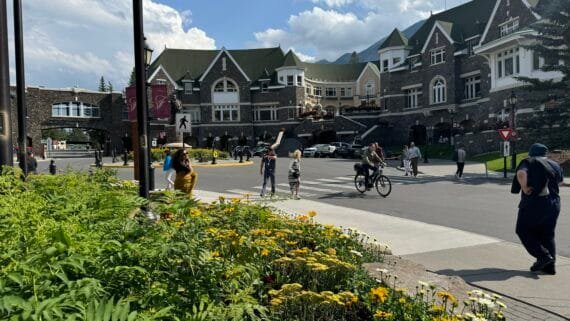 Later that afternoon we checked into our next hotel, the Fairmont Banff Springs, a luxurious property that looks like a grand palace. It felt like a town in itself, with an underground mall and several restaurants. The hotel offered many luxury amenities, such as yoga and gym classes, bike and horse rentals, a swimming pool, a spa, and more. It was the perfect place for us to treat ourselves after all the strenuous activity. Each wing of the hotel has a cozy lobby equipped with many games for guests to enjoy. We in particular enjoyed playing pool and Scrabble.
Later that afternoon we checked into our next hotel, the Fairmont Banff Springs, a luxurious property that looks like a grand palace. It felt like a town in itself, with an underground mall and several restaurants. The hotel offered many luxury amenities, such as yoga and gym classes, bike and horse rentals, a swimming pool, a spa, and more. It was the perfect place for us to treat ourselves after all the strenuous activity. Each wing of the hotel has a cozy lobby equipped with many games for guests to enjoy. We in particular enjoyed playing pool and Scrabble.
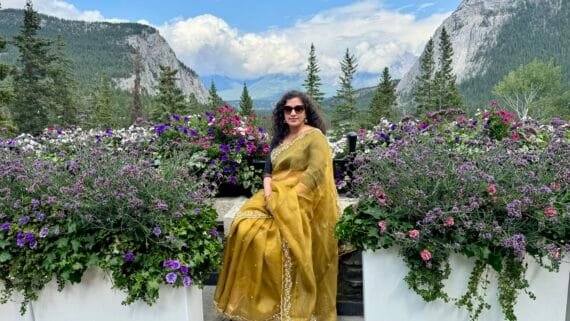
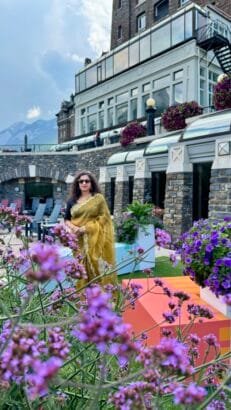 Before traveling I had the fun idea of carrying a saree for a picture opportunity, and this palace-like hotel provided the perfect backdrop. The kids, eager to make their TikTok videos, got us parents to dance in random locations—a bit out of character for us, but everyone had their own wishlist to fulfill during our family vacation. While the kids hung out at the heated pool after a few hours of biking, we enjoyed some quiet time walking and reading.
Before traveling I had the fun idea of carrying a saree for a picture opportunity, and this palace-like hotel provided the perfect backdrop. The kids, eager to make their TikTok videos, got us parents to dance in random locations—a bit out of character for us, but everyone had their own wishlist to fulfill during our family vacation. While the kids hung out at the heated pool after a few hours of biking, we enjoyed some quiet time walking and reading.

On our last day we received a rewarding surprise: our company, ConnectM, ranked 104th among Inc. 5000 companies. Even more exciting, ours is one of only 74 companies out of 5000 to rank three years in a row. These were amazing achievements for our family, so we celebrated our final night with a fancy Italian dinner at Castello, located inside the hotel.
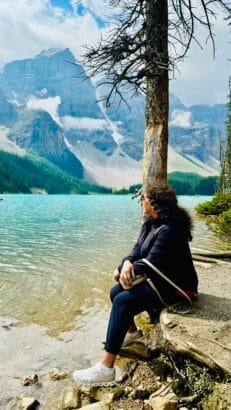
A personal highlight for me was finding some peaceful moments to immerse myself in Krishnaveni re Sandhya (The Evening by the Krishnaveni River), a historical novel about Odisha’s past, penned by the esteemed author Sri Surendra Mohanty in the mid-1980s. This timeless classic, interwoven with themes of bravery, sacrifice, treachery, and romance, offers profound historical insights. While the title might evoke images of a romantic evening by the river, the author’s true intention was to underscore the tragic decline of the Kalinga kingdom. Once a vast empire stretching from the Ganges to the Kaveri River, it was reduced to the northern border of the Krishna River following an unrighteous war by Kanchi in the first half of 1500 AD. The title here signifies the dawn of the Kalinga empire from that point onwards. This historical context adds a profound layer of meaning to the narrative, reminding readers of the harsh realities behind the poetic title. It’s a must-read for any Odia with a deep appreciation for literature.
Every vacation is a sojourn that eventually comes to an end. However, the breathtaking sights of nature—the picturesque mountains stretching as far as the eye can see, the serene turquoise lakes, and the beds of towering pine trees—will linger in our hearts, cherished memories that will stay with us for a long time. Until we return, these vivid impressions will continue to inspire and remind us of the beauty we experienced together.
Manorama Choudhury
Aug 8th, 2024
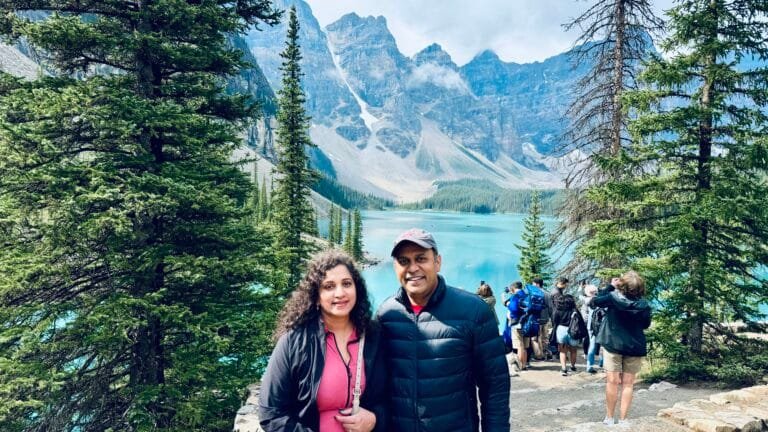

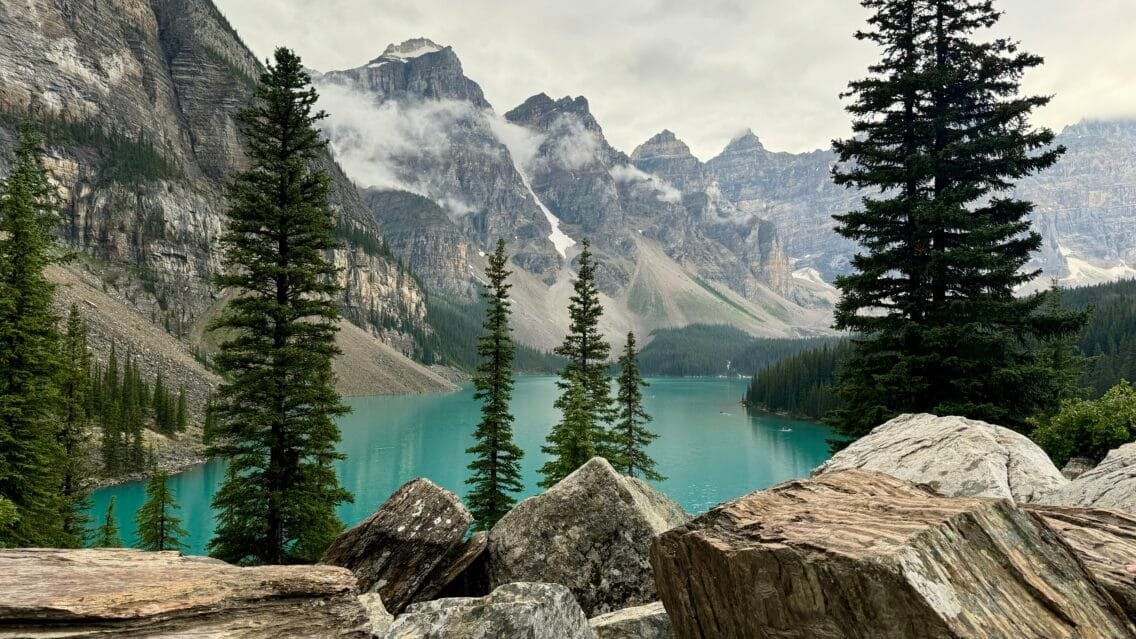
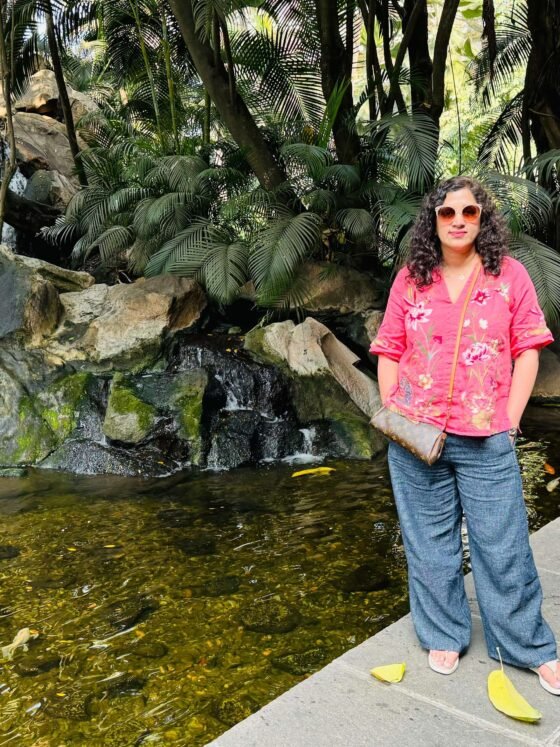
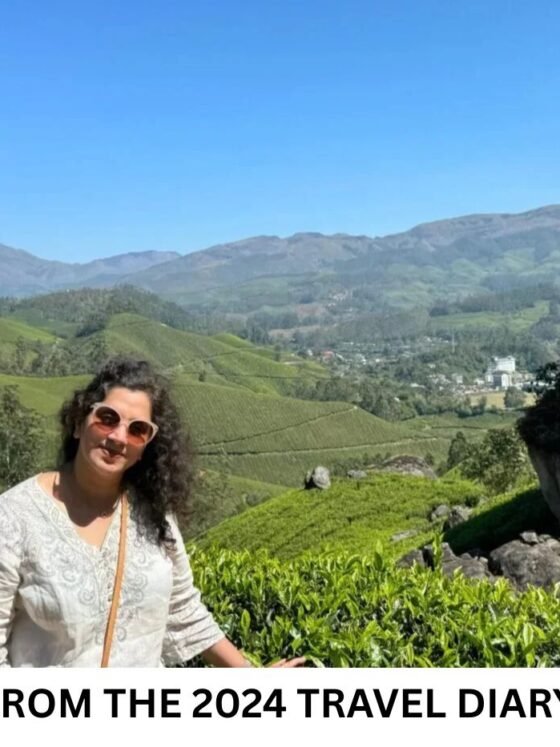
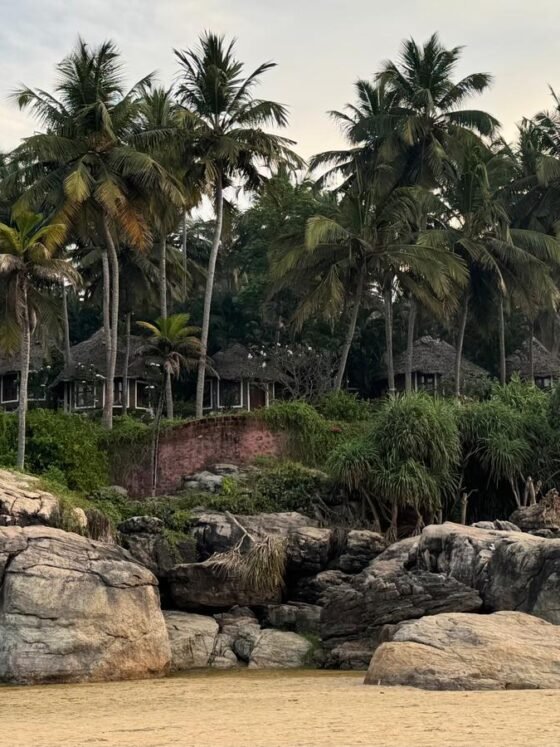
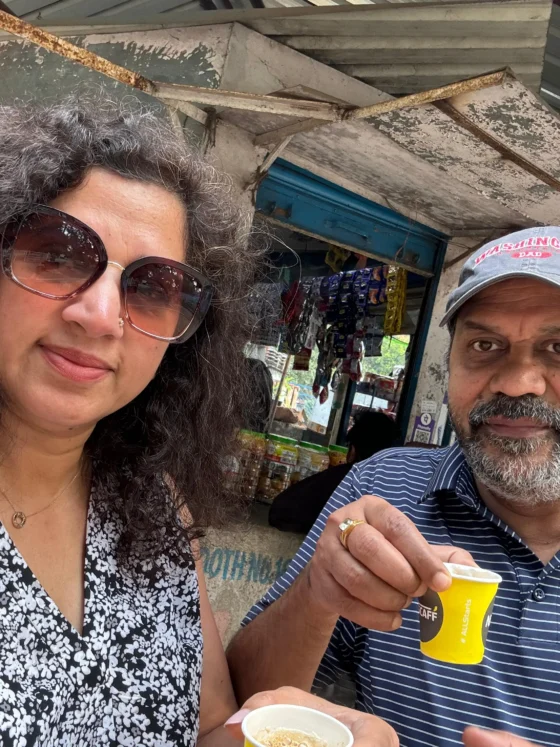
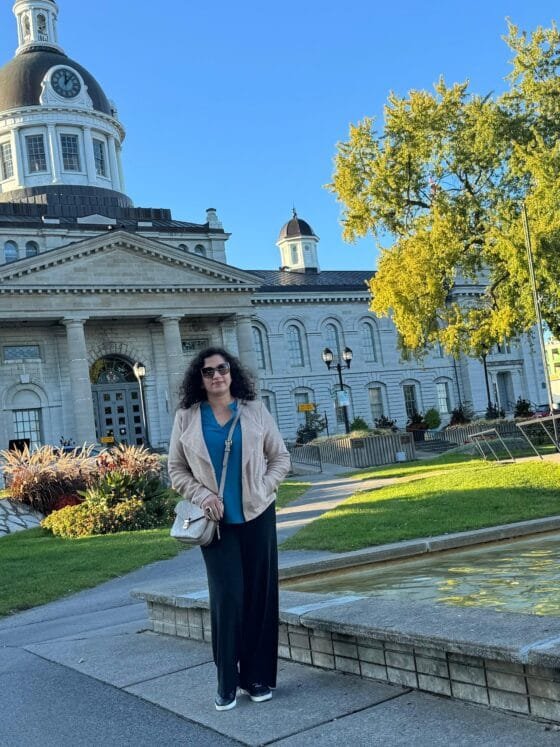
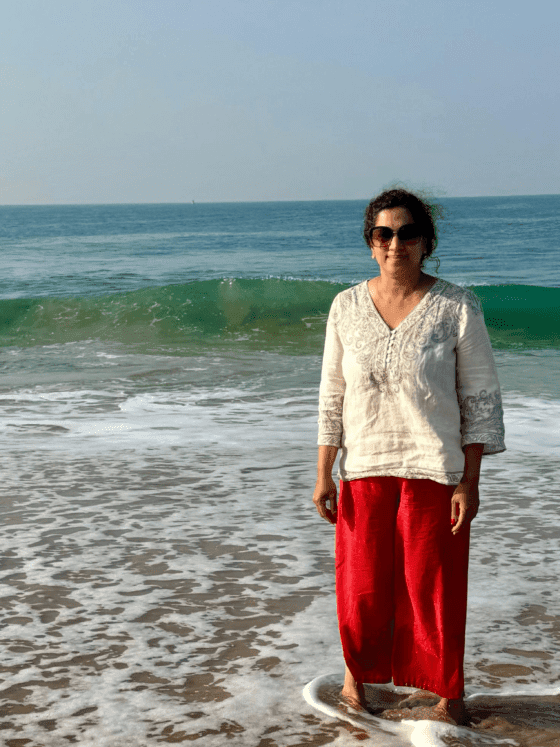
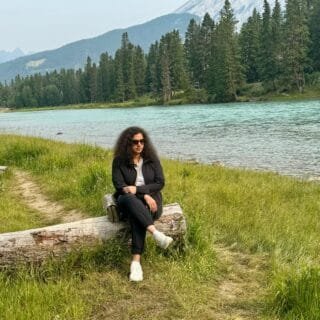
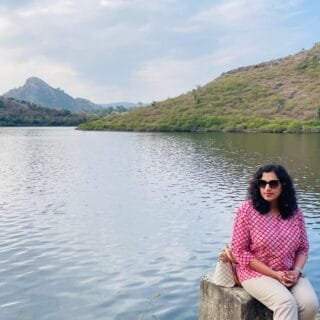
Subrat Mohanty
11/06/2024Wow, it indeed looks like heaven on earth—such a scenic and romantic place! Definitely adding it to my list as well. Your description is so fabulous.
Manorama Choudhury
11/07/2024It is a beautiful place and worth visiting! Thank you!